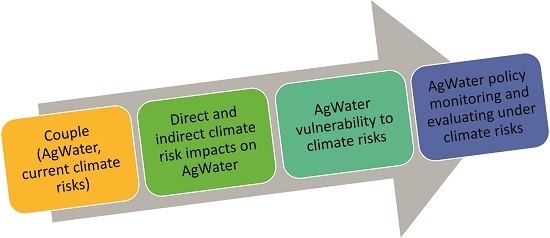Using a New Approach to Design Innovative Tools for Monitoring and Evaluating Water Policy of Burkina Faso in Response to Climate Risks
Abstract
:1. Introduction
2. Method
2.1. Study Field
2.2. Data
2.3. ClimProspect Model
2.3.1. Overview of the Model and Its Application to the AgWater Vulnerability Analysis
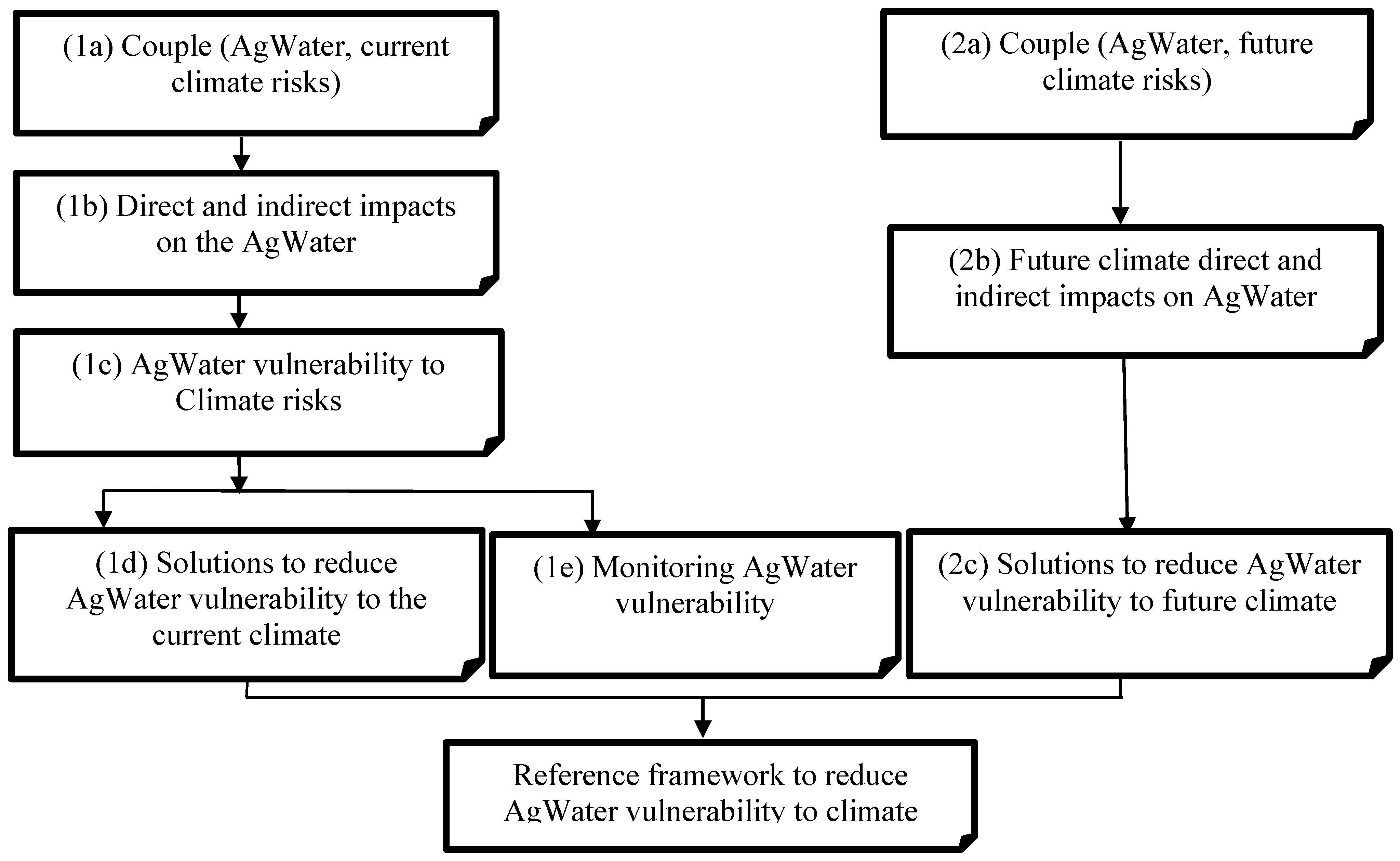
- a.
- the specification of both the system vector (ES) and risk vector (R). The system vector is the system targeted, here AgWater. The risk vector includes the most important climate risks experienced in the area where system is located. In the Nakanbé basin, these risks are droughts, floods and heat weaves;
- b.
- R impact assessment on ES. It is matter of identifying impacts of each climate risks on the targeted system;
- c.
- ES vulnerability assessment. It consists of identifying for each impact the key vulnerability factors that make the targeted system to be vulnerable to the climate risks.

2.3.2. Definition of Vector ES and Vector System Risk R
- e1: AgWater supply, refers to the quantity of water for irrigation. It includes Bagré dam, Mogtédo Reservoir and non-permanent Nakanbe river strictosensus (Nakanbess). Bagré dam, with an initial storage of 1700 million cubic meters (Mm3), has both hydro-agricultural and hydropower functions. Mogtédo reservoir has an initial storage of 6.5 Mm3 [36,37] is for irrigation only. Both Mogtédo Reservoir and Bagré dam are fed by the river Nakanbess and its tributaries. Nakanbé River is shared with Ghana, a neighbouring country;
- e2: water quality includes sedimentation and siltation in the aforesaid water sources. Although, there is pollution from the use of fertilizers, sedimentation represents the major water problem in the sense of quality for the country (contribution of water turbidity, siltation, etc). Therefore, it is considered as a major issue to be solved to the face of climate risks.
- e3: water demand refers to the crop water needs, including major crops in growing season (rice) and dry season vegetable like onion;
- e4: the management system which refers to the managerial frameworks, namely Ministry of Water, General Directory of Water Resources (DGRE), Nakanbé Basin Board (NBA) and the Water Local Committee (CLE).
2.3.3. Impacts of Vector R on Vector Es

2.3.4. ES Vulnerability to R
- a.
- vulnerability linked to early warning so-called vulnerability class V1,
- b.
- vulnerability linked to response so-called vulnerability class V2,
- c.
- vulnerability linked to recovery so-called vulnerability class V3, and
- d.
- structural vulnerability so-called vulnerability class V4.

2.3.5. Monitoring Vulnerability and Resilience Indicators
2.4. Integrated AgWater Monitoring Index
| Value Range | In Percentage | Classification | Interpretation |
|---|---|---|---|
| ≥ 0.9% | ≥90% | Higher to steady resilience | Water resources resilience to climate risks and change (CC&R) is very high. However, it requires preventive monitoring. |
| 0.7 - < 0.9% | 70 - < 90% | High tohigher resilience | Water resources are more or less resilient. Both reactive and proactive initiatives are strongly needed. |
| 0.5 - < 0.7% | 50 - < 70% | Moderate to high resilience | Moderate or high resilience. Efforts in specific classes are required |
| 0.2 - < 0.5% | 20 - < 50% | Low to moderate resilience | Moderate or low resilience. Significant efforts are required. |
| ≤ 0.2% | ≤20% | Severe vulnerability | Water resources are extremely vulnerable to CC&R. It calls for urgent efforts at all levels |
2.5. Application of the Index at Three Agriculture Sites in Burkina Faso
3. Results
3.1. Vulnerability Mapping
| The Components of the Vector e | r1 (Droughts) | r2 (Floods) | r3 (Heat Weaves) | ||||
|---|---|---|---|---|---|---|---|
| Direct Impacts | Indirect Impacts | Consequences on Agricultural Productivity (a) and on Farmers (b) | |||||
| e1 (Water supply) | Reduction in stored water volume | —Overflow of the river from its banks; —loss of storage capacity by damage to the dam and reservoir | Evaporation from water sources causing a reduction in water supply | —Reduction in water stored for irrigation —deficit in functioning of the dam and reservoir due to silting —water supply restriction for food production | (a): —Food productivity cycle shortening —planting destruction (flood) or a failure in crop growth —reduction in arable land area —decrease in yield —decrease in or loss of food production (b) —Changes in agricultural practices (increase in works load, field desertion) —food price increase —loss of incomes —food shortage —poor nutritional quality —asset liquidation and debt —increase in rural exodus and migration towards coastal countries (Cote d’Ivoire and Ghana) | ||
| e2 (Water quality) | —Increase in silting concentration in the water sources due to reduction in water amount | —Increase in silting in the water sources due to soil erosion —reduction in stored water for irrigation | —Evaporation from water sources; —increase in silting concentration in the water sources | ||||
| e3 (Water demand) | —Imbalance between water supply and demand | —Crop water demand becomes too low due to higher humidity | —Increase in crop water demand | ||||
| e4 (water managerial frameworks) | —inefficiency of water management frameworks (failure in their initiatives); —amplification of stakeholder’s solicitation to decision makers | —Increase in conflicts among users. —AgWater development financing reallocation to face conflicts and food crisis —difficulties to implement IWRM | (a) —Decrease in food production (b) —Low participation of farmers in IWRM; —conflicts among users —desertion of farmer social network —assets liquidation and debt —rural exodus and migration intensification | ||||
- V1 = {Deficits in early warning systems related to water availability and prevention against conflicts}
- V2 = {lack of the alternative water sources to the Nakanbé River, Mogtédo reservoir and Bagré dam to supply crops in dry seasons; deficits in the agricultural water allocation mechanisms in dry seasons; deficits in the conflict management strategies; inadequacies in the mechanisms to face food shortages}
- V3 = {Deficits in the recovery mechanisms and devices in response to climate risks for the farmers}
- V4 = {Deficits in the water source planning to respond to climate risks; poor agricultural practices around the water bodies and the river; deficits in mainstreaming climate risks into the design, implementation and management of the water sources; land degradation in the Nakanbé basin; inefficiency of water saving strategies and techniques as regards heat waves and droughts; deficits in integrating climate risks in designing and implementing the water management frameworks for crop production; deficits in mainstreaming climate risks into the water policy and regulations}
3.2. AgWater Resilience Indicators
| Vulnerability Classes | Vulnerability Factors (VF) | Vulnerability Indicators | Resilience Indicators |
|---|---|---|---|
| warning (VF = 2) | Lack of robust warning concerning water availability | 1. Proportion of farmers that have no access to early warning | 1. Proportion of farmers that have access to early warning |
| 2. Proportion of climate risks occurred without warning | 2. Proportion of climate risks preceded by warning | ||
| Gap in early warning system on water related-conflicts (information gathering, processing and dissemination) | Proportion of conflicts related to agricultural water shortage | Proportion of water shortage seasons without conflicts with help from early warning | |
| Response (VF = 3) | Lack of reliable alternatives to Nakanbé River, Bagré dam and Mogtédo reservoirs to irrigate farms in the dry season | 1. Proportion of AgWater sources without alternative water in the dry season | 1. Proportion of water sources having alternative to water crops in the dry season |
| 2. Proportion of farmers without alternative water sources to irrigate their farms in the dry season | 2. Proportion of farmers having alternative water sources to irrigate their farms in the dry season | ||
| Deficits in the AgWater allocation mechanisms during dry periods | 1. Proportion of the dry season (water shortage) with conflict | 1. Proportion of the dry season (water shortage) without conflict | |
| 2. Proportion of AgWater sources without reliable water allocation model | 2. Proportion of AgWater sources having reliable water allocation model | ||
| Deficit in conflict management mechanisms related to AgWater use | Proportion of AgWater shortage with conflict | Proportion of AgWater shortage without conflict | |
| Recovery (VF = 4) | Gap in food safety net | Proportion of farmers whose needs for recovery from climate risk have not been met utterly | Proportion of farmers whose needs for recovery from climate risk have been met utterly |
| Lack of climate assurance mechanisms | Proportion of farms not having access to climate assurance | Proportion of farms having access to climate assurance | |
| Lack of access to AgWater for recovery | Proportion of farmers not having access to AgWater source for recovery | Proportion of farmers having access to AgWater source for recovery | |
| Deficit in access to fertilizers and seeds for recovery | Proportion of farms not having access to fertilizer and seeds for recovery | Proportion of farms having access to fertilizer and seeds for recovery | |
| Structural vulnerability (VF = 7) | Deficits in the water source planning to face the silting | Proportion of the water sources in which silting rate increase per year | 1. Proportion of the water sources in which silting rate decrease per year |
| Poor agricultural practices (around the water bodies and rivers) | Proportion of the water sources of which the safety zone (100m) is occupied by farms | Proportion of the water sources of which the safety zone (100m) is not occupied by farms | |
| Deficits in mainstreaming climate risks into the design and management of the water sources | Proportion of the AgWater infrastructure not working properly in case of climate risks | Proportion of the AgWater infrastructure working properly in case of climate risks. | |
| Land degradation in the Nakanbé Basin | 1. Proportion of the degraded area (non covered by trees) at the basin level | 1. Proportion of the area covered by trees at the basin level | |
| 2. Proportion of non agro-ecological farm area in the basin | 2. Proportion of agro-ecological farm area in the basin | ||
| Low use of water saving and productivity strategies, mechanisms and techniques as regards the heat waves and droughts | 1. Proportion of farm whose yield decrease per agricultural campaign | 1. Proportion of farm whose yield increase per agricultural campaign | |
| 2. Proportion of farmers with unmet AgWater demand in the dry season | 2. Proportion of farmers whose AgWater demand has been met in the dry season | ||
| Deficits in integrating climate risks in designing and running of the water managerial frameworks for crop production (CR Department, climate information device…) | Proportion of the WR frameworks that have not explicitly taken into account climate change and risks (CC&R) | Proportion of the water managerial frameworks with CC resilience mechanisms or devices | |
| Deficits in mainstreaming CC into the water policy and regulations of Burkina Faso | Proportion of the water policy and regulations documents which have not explicitly taken into account climate change | Proportion of the water policy and regulations documents which have clearly integrated CC&R |
3.3. AgWater Resilience Index
| Indice | Weight | BoboJardin | Tanguin | Boulimiougou |
|---|---|---|---|---|
| Warning | 1 | 0 | 0 | 0 |
| Response | 1 | 50 | 40 | 35 |
| Recovery | 1 | 23.3 | 24.2 | 37.32 |
| Structural resilience | 2 | 20 | 33.83 | 24.22 |
| Indice value/100 | 22.66 | 26.37 | 24.15 | |
| Resilience class | Low | Low | Low |
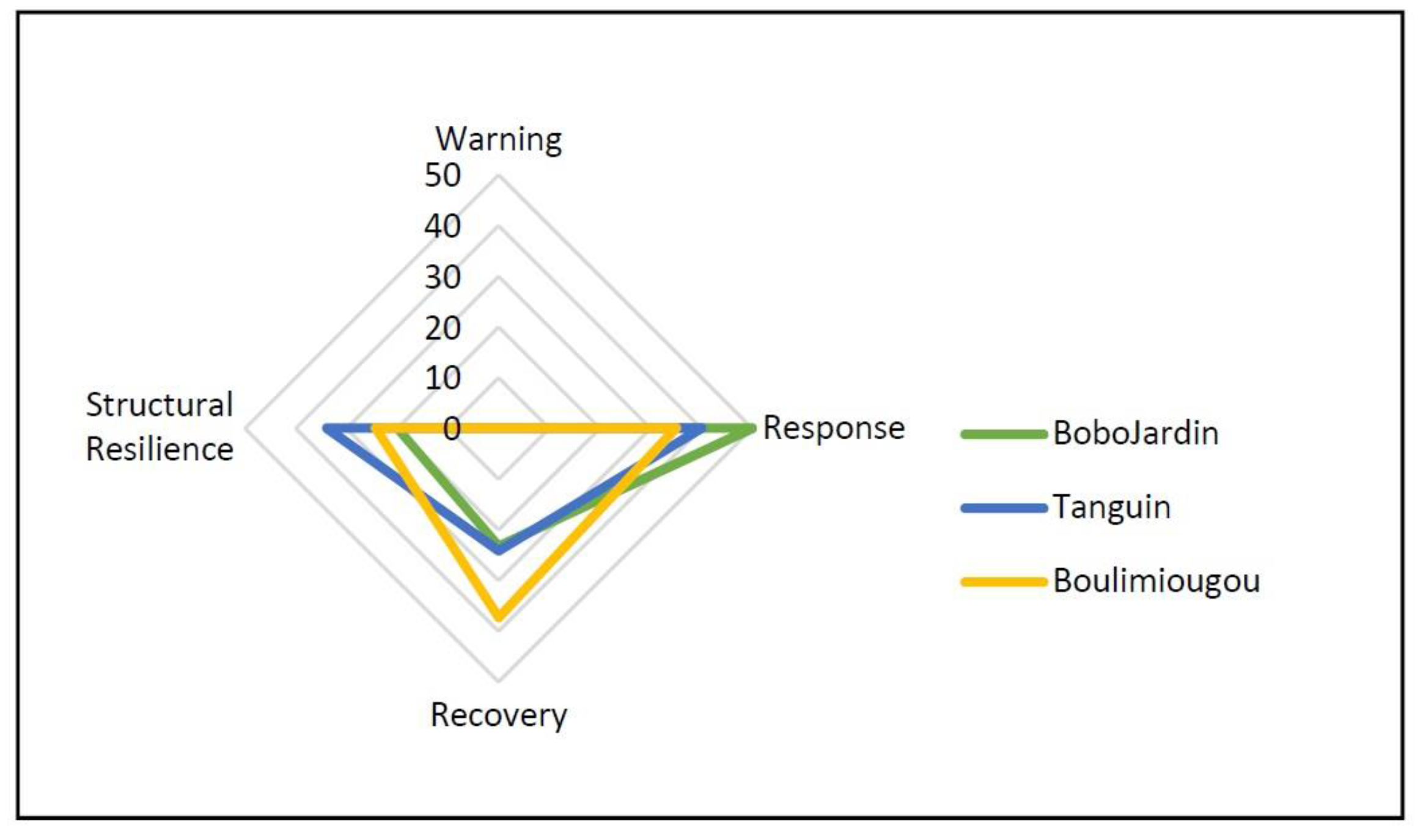
4. Discussion
- a.
- to overcome lack of robust warning delivery, there is a need to put in place indicators to measure progress in delivering early warning;
- b.
- to meet AgWater demand calls for response indicators;
- c.
- to assure food security after risks requires recovery indicators, and
- d.
- to reduce land degradation and deficits in mainstreaming CC into the water policy and regulations call for structural indicators.
5. Conclusions
Acknowledgments
Author Contributions
Conflicts of Interest
Appendix
Rainfall and Temperature Trends during 1952–2012 at Ouagadougou
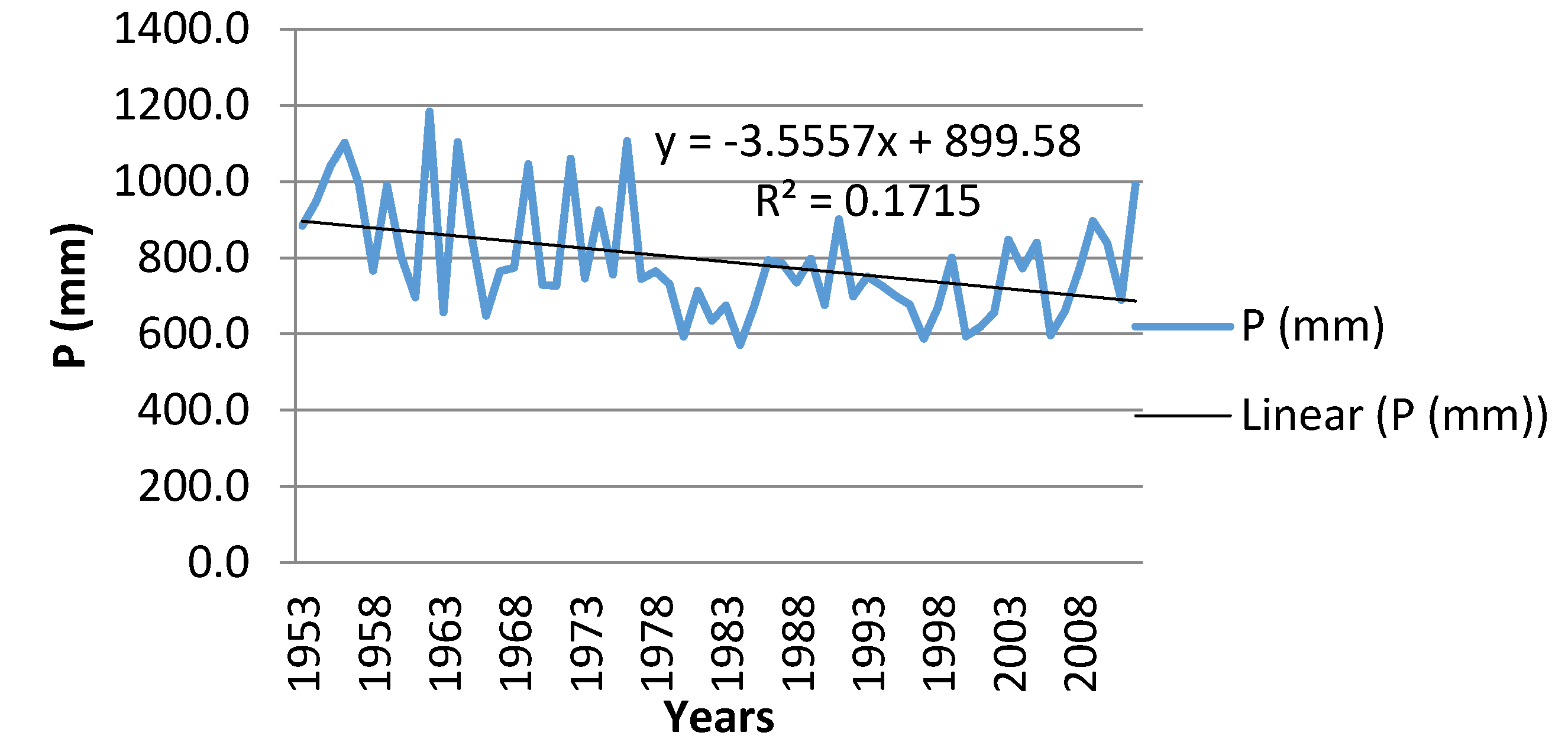
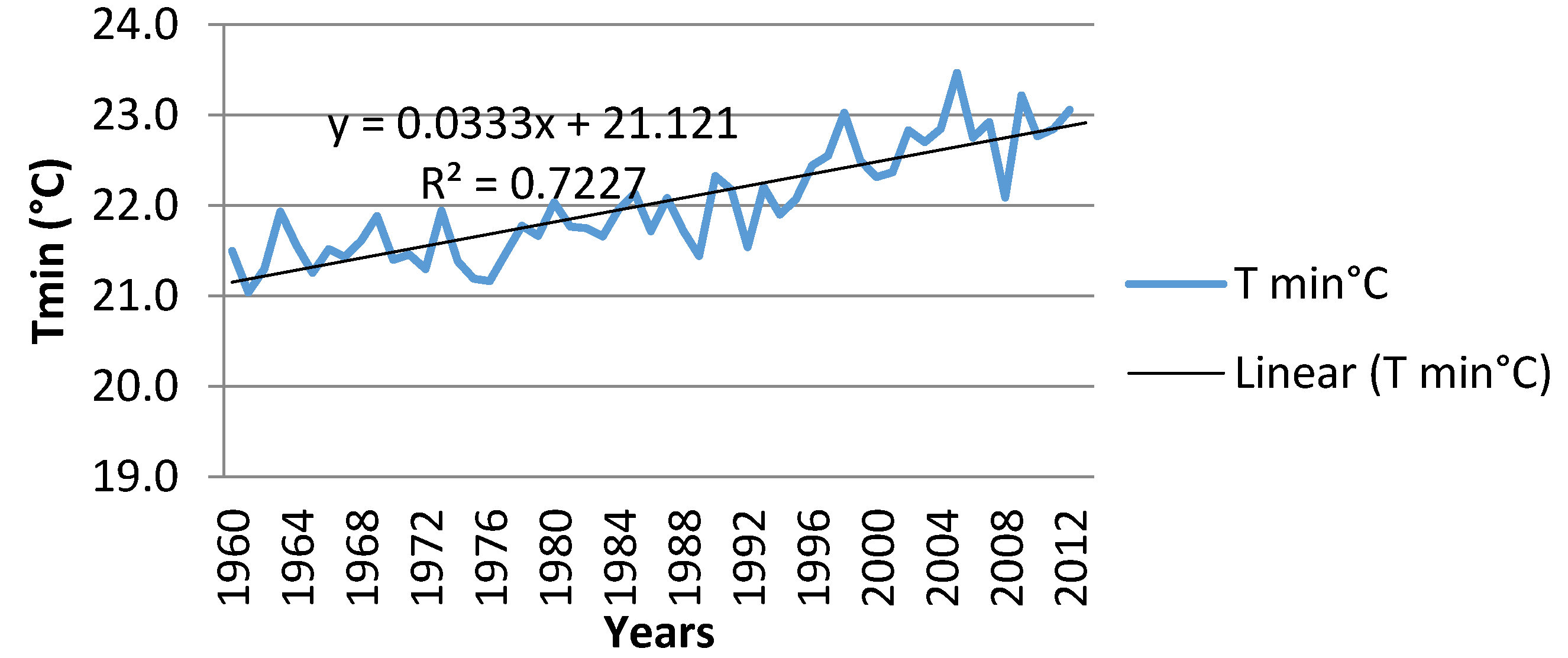
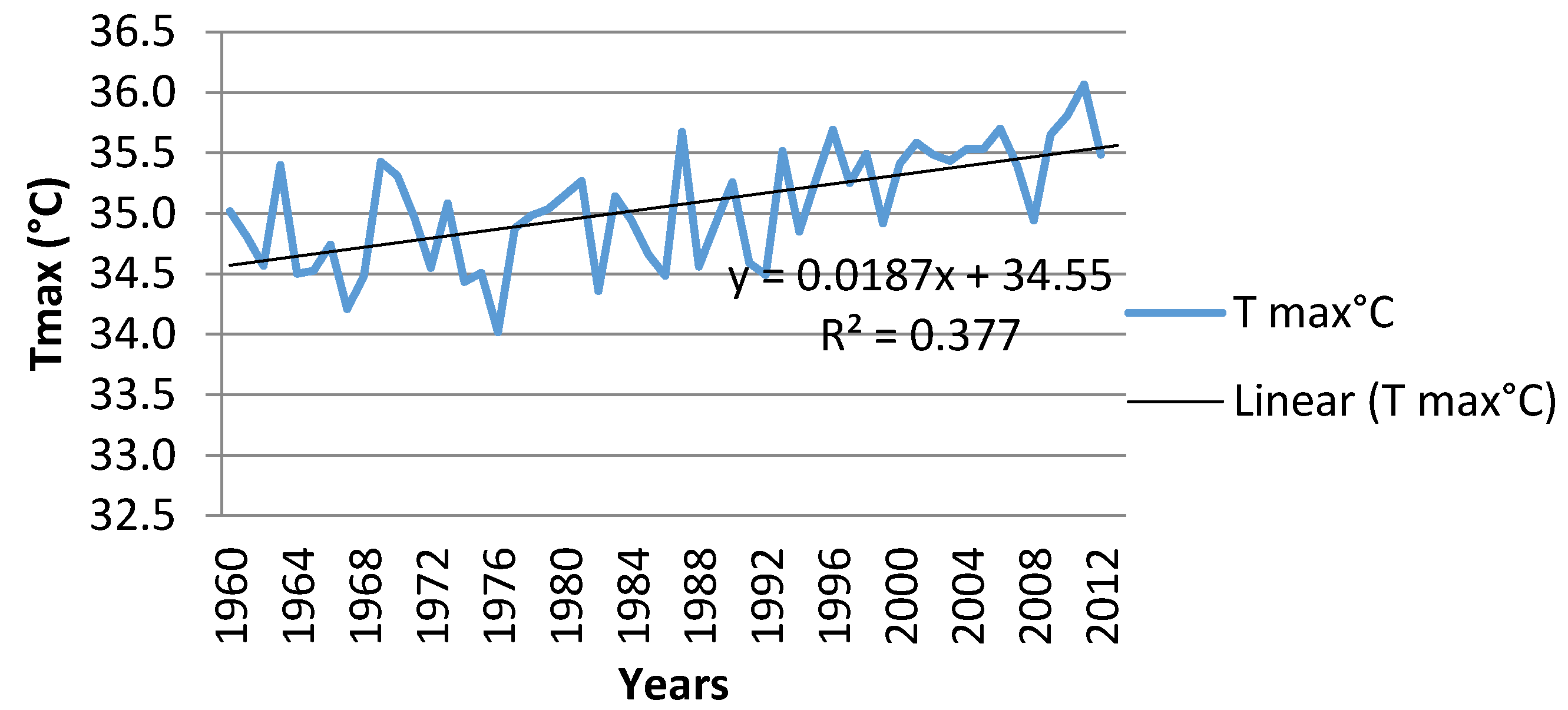
References
- Engle, N.L.; de Bremond, A.; Malone, E.L.; Moss, R.H. Towards a resilience indicator framework for making climate-change adaptation decisions. Mitig. Adapt. Strateg. Glob. Change 2014, 19, 1295–1312. [Google Scholar] [CrossRef]
- Ibrahim, B.; Karambiri, H.; Polcher, J. Hydrological impacts of the changes in simulated rainfall fields on Nakanbe Basin in Burkina Faso. Climate 2015, 3, 442–458. [Google Scholar] [CrossRef]
- Intergovernmental Panel of Climate Change. Climate Change 2014: Synthesis Report; IPCC: Geneva, Switzerland, 2014. [Google Scholar]
- Sarr, B. Present and future climate change in the semi-arid region of West Africa: A crucial input for practical adaptation in agriculture. Atmos. Sci. Let. 2012, 13, 108–112. [Google Scholar] [CrossRef]
- United Nations Environment Programme. Livelihood Security: Climate Change, Conflict and Migration in the Sahel; UNEP: Nairobi, Kenya, 2011. [Google Scholar]
- Mahe, G.; Diello, P.; Paturel, J.E.; Barbier, B.; Karambiri, H.; Dezetter, A.; Dieulin, C.; Rouche, N. Baisse des pluies et augmentation des écoulements au Sahel : Impact climatique et anthropique sur les écoulements du Nakambe au Burkina Faso. Sécheresse 2010, 21, 330–332. [Google Scholar]
- Hein, L.; Marc, J.; Metzger, J.M.; Leemans, R. The local impacts of climate change in the Ferlo, Western Sahel. Clim. Change 2009, 93, 465–483. [Google Scholar] [CrossRef]
- Serigne, T.; Kandji, S.T.; Verchot, L.; Mackensen, J. Climate Change and Variability in the Sahel Region: Impacts and Adaptation Strategies in the Agricultural Sector; United Nations Environment Programme: Nairobi, Kenya, 2006. [Google Scholar]
- Barbier, B.; Yacouba, H.; Karambiri, H.; Zoromé, M.; Somé, B. Human vulnerability to climate variability in the Sahel: Farmers’ adaptation strategies in Northern Burkina Faso. Environ. Manag. 2009, 43, 770–803. [Google Scholar] [CrossRef] [PubMed]
- Ludeke, B.K.; Moldenhauer, O.; Petschel-Held, G. Rural poverty driven soil degradation under climate change: The sensitivity of the disposition towards the Sahel Syndrome with respect to climate. Environ. Model. Assess. 1999, 4, 315–326. [Google Scholar] [CrossRef]
- Morris, J.; Barron, J. Agricultural Water Management Technology Expansion and Impact on Crop Yields in Northern Burkina Faso (1980–2010): A Review; CGIAR Research for Development Series, R4D Series 10; International Water Management Programme: Colombo, Sri Lanka, 2014. [Google Scholar]
- Barry, B.; Obuobie, E.; Andreini, M.; Andah, W.; Pluquet, M. Comprehensive Assessment of Water Management in Agriculture: Comparative Study of River Basin Development and Management; International Water Management Institute: Colombo, Sri Lanka, 2005. [Google Scholar]
- Sanfo, S.; Gérard, F. Public policies for rural poverty alleviation: The case of agricultural households in the Plateau Central area of Burkina Faso. Agric. Syst. 2012, 110, 1–9. [Google Scholar] [CrossRef]
- Volta Basin Authority. Assessment of the Basin’s Socio-Economic and Environmental Situation And Analysis of the Problem Areas and Issues Regarding Sustainable Management of Water Resources; Volta Basin Authority: Ouagadougou, Burkina Faso, 2012. [Google Scholar]
- World Bank. Inondations du 1er Septembre 2009 au Burkina Faso: Evaluation des Dommages, Pertes et Besoins de Construction, de Reconstruction et de Relèvement, Rapport Restitué de l’Evaluation Conjointe du 19 Octobre au 6 Novembre, 2009. Available online: http://documents.banquemondiale.org/curated/fr/2010/04/13188840 (accessed on 20 October 2015).
- De Condappa, D.; Chaponnière, A.; Lemoalle, J. A decision-support tool for water allocation in the Volta Basin. Water Int. 2009, 34, 71–87. [Google Scholar] [CrossRef]
- Permanent Interstate Committee for Drought Control in the Sahel. Available online: www.cilss.bf (accessed on 20 August 2015).
- Volta Basin Authority. Available online: www.abv-volta.org (accessed on 18 August 2015).
- Huang, Y.; Cai, M. Methodologies Guidelines. Vulnerability Assessment of Freshwater Resources to Environmental Change; Peking University of China: Beijing, China, 2009. [Google Scholar]
- Forouzani, M.; Karami, E. Agricultural water poverty index and sustainability. Agron. Sustain. Dev. 2011, 31, 415–432. [Google Scholar] [CrossRef]
- Katharine, V. Creating an Index of Social Vulnerability to Climate Change for Africa; Tyndall Centre for Climate Change Research: Norwich, UK, 2004. [Google Scholar]
- Sullivan, C.; Meigh, J. Targeting attention on local vulnerabilities using an integrated index approach: The example of the Climate Vulnerability Index. Water Sci. Technol. 2005, 51, 5. [Google Scholar]
- Garth, A.; Brett, C.; Harris, M.; Romney, A.; Mario, R.; Zollweg, J.; Vodacek, A.; Tomaszewski, B. Modeling Social Vulnerability in Burkina Faso. Available online: http://www.esri.com/news/arcuser/0112/modeling-social-vulnerability-in-burkina-faso.html (accessed on 21 October 2015).
- Brooks, N.; Anderson, S.; Burton, I.; Fisher, S.; Rai, N.; Tellam, I. An Operational Framework for Tracking Adaptation and Measuring Development; International Institute for Environment and Development: Edinburgh, UK, 2013. [Google Scholar]
- Nazari, S.; Rad, G.P.; Sedighi, H.; Azadi, H. Vulnerability of wheat farmers: To a conceptual framework. Ecol.Indic. 2015, 52, 517–532. [Google Scholar] [CrossRef]
- Cruz, S.; Paulino, S. Public service innovation and evaluation indicators. J. Technol. Manag. Inonv. 2013, 8, 13. [Google Scholar] [CrossRef]
- Ibrahim, B.; Polcher, J.; Karambiri, H.; Yacouba, H.; Ribstein, P. Changes in rainfall regime over Burkina Faso under the climate change conditions simulated by 5 regional climate models. Clim. Dyn. 2014, 42, 1363–1381. [Google Scholar] [CrossRef]
- Secrétariat Permanent du Conseil National de l’Environnement et du Développement Durable. Programme d’Action National d’Adaptation à la Variabilité et aux Changements Climatiques; Ministère de l’Environnement et du Cadre de Vie: Ouagadougou, Burkina Faso, 2007. [Google Scholar]
- Sandwidi, J.P. Groundwater Potential to Supply Population Demand within the KompiengaDam Basin in Burkina Faso. Ph.D. Thesis, Rheinischen Friedrich-Wilhelms-Universität, Bonn, Germany, 2007. [Google Scholar]
- Ministère de l’Environnement et de l’Eau. Etat des Lieux des Ressources en Eau et de Leur Cadre de Gestion. Available online: http://www.eaugourma.bf/spip.php?article137&lang=en (accessed on 23 October 2015).
- Ibrahim, B.; Rockel, B.; Polcher, J.; Karambiri, H. Characterization of the rainy season in Burkina Faso and it’s representation by regional climate models. Clim. Dyn. 2012, 39, 1287–1302. [Google Scholar] [CrossRef]
- Asare-Kyei, D.; Forkuor, G.; Venus, V. Modeling flood hazard zones at the sub-district level with the rational model integrated with GIS and Remote Sensing approaches. Water 2015, 7, 3531–3564. [Google Scholar] [CrossRef]
- European Food Safety Authority. Guidance on expert knowledge elicitation in food and feed safety risk assessment. EFSA J. 2014, 12, 3734. [Google Scholar]
- Bauwens, A.; Brussel, U.Z. The use of method triangulation in probation research. Eur. J. Prob. 2010, 2, 39–52. [Google Scholar] [CrossRef]
- Badolo, M. Aspects Théoriques et Méthodologiques de la Gestion des Effets des Risques et Changements Climatiques: Approche Opérationnelle pour l’Elaboration du Cadre de Référence pour l’Adaptation au Climat et à ses Changements; Institut d’Application et de Vulgarisation en Sciences: Ouagadougou, Burkina Faso, 2014. [Google Scholar]
- Sally, H.; Lévite, H.; Cour, J. Local water management of small reservoirs: Lessons from two case studies in Burkina Faso. Water Altern. 2011, 4, 365–382. [Google Scholar]
- Cecchi, P.; Meunier-Nikiema, A.; Moiroux, N.; Sanou, B. Towards an Atlas of Lakes and Reservoirs in Burkina Faso; IRD: Montpellier, France, 2008. [Google Scholar]
- Miller, F.; Osbahr, H.; Boyd, E.; Thomalla, F.; Bharwani, S.; Ziervogel, G.; Walker, B.; Birkmann, J.; der Leeuw, S.V.; Rockström, J.; et al. Resilience and vulnerability: Complementary or conflicting concepts? Ecol. Soc. 2010, 15, 11. [Google Scholar]
- Sullivan, C.A.; Meigh, J.R.; Giacomello, A.M.; Fediw, T.; Lawrence, P.; Samad, M.; Mlote, S.; Hutton, C.; Allan, J.A.; Schulze, R.E.; et al. The water poverty index: Development and application at the community scale. Nat. Res. Forum 2003, 27, 189–199. [Google Scholar] [CrossRef]
- Badolo, M. Ajustement des Schémas de Gestion de la Vulnérabilité Actuelle de la Sécurité Alimentaire au Sahel pour la Réduction des Coûts d’Adaptation aux Changements Climatiques: Aspects Théoriques et Approches Méthodologiques. Available online: http://www.iavs-bf.org/notes_de_recherche.html (accessed on 20 October 2015).
- Emerson, J.W.; Hsu, A.; Levy, M.A.; de Sherbinin, A.; Mara, V.; Esty, D.C.; Jaiteh, M. Environmental Performance Index and Pilot Trend Environmental Performance Index; Yale Center for Environmental Law and Policy: New Haven, CT, USA, 2012. [Google Scholar]
- Garriga, G.; Foguet, P. Improved method to calculate a Water Poverty Index at local scale. J. Environ. Eng 2010, 136, 1287–1298. [Google Scholar] [CrossRef]
- Boelee, E.; Yohannes, M.; McCartney, M.; Hagos, F.; Cecchi, P.; Laamrani, H. Options for water storage and rainwater harvesting to improve health and resilience against climate change in Africa. Reg. Environ. Change 2013, 13, 509–519. [Google Scholar] [CrossRef]
- Brown, O.; Crawford, A. Assessing the Security Implications of Climate Change for West Africa: Country Case Studies of Ghana and Burkina Faso; International Institute for Sustainable Development: Winnipeg, MB, Canada, 2008. [Google Scholar]
- DasGupta, R.; Shaw, R. An indicator based approach to assess coastal communities’ resilience against climate related disasters in Indian Sundarbans. J. Coast Conserv. 2015, 19, 85–101. [Google Scholar] [CrossRef]
- AZurieta, I.; Sithole, B.N.; Hunter-Xenie, H.; Campbell, B.; Donohoe, P.; Brown, J.; Wilson, L. Developing indicators for monitoring and evaluating joint management effectiveness in protected areas in the Northern Territory, Australia. Ecol. Soc. 2011, 16, 9. [Google Scholar] [CrossRef]
- Fussl, H.-M. How inequitable is the global distribution of responsibility, capability, and vulnerability to climate change: A comprehensive indicator-based assessment. Global Environ. Change 2010, 20, 597–611. [Google Scholar] [CrossRef]
- Sullivan, C.; Meigh, J.; Lawrence, P. Application of the Water Poverty Index at different scales: A cautionary tale. Water Int. 2006, 31, 412–426. [Google Scholar] [CrossRef]
- Adger, W.B.; Brooks, N.; Kelly, M.; Bentham, G.; Agnew, M.; Eriksen, S. New Indicators of Vulnerability and Adaptive Capacity; Tyndall Centre for Climate Change Research: Norwich, UK, 2004. [Google Scholar]
- Kaly, U.L.; Pratt, C.R.; Mitchell, J. The Demonstration Environmental Vulnerability Index (EVI) 2004; SOPAC Technical Report; South Pacific Applied Geoscience Commission: Suva, Fiji, 2004. [Google Scholar]
- Sullivan, C. Calculating a Water Poverty Index. World Dev. 2002, 30, 1195–1210. [Google Scholar] [CrossRef]
- Koshida, G.; Cohen, S.; Mortsch, L. Climate and water availability indicators in Canada: Challenges and a way forward. Can. Water Res. J. 2015, 40, 1–13. [Google Scholar] [CrossRef]
- Mekis, E.; Vincent, L.A. An overview of the second generation adjusted daily precipitation dataset for trend analysis in Canada. Atmos. Ocean 2011, 49, 163–177. [Google Scholar] [CrossRef]
- Sullivan, C.; Byambaa, E. The application of the Climate Vulnerability Index in Mongolia. In Proceedings of the 2013 Workshop of Climate Adaptation, Geneva, Switzerland, 25–26 June 2013.
- O’Connell, D.; Walker, B.; Abel, N.; Grigg, N. The Resilience, Adaptation and Transformation Assessment Framework: From Theory to Application; CSIRO: Sydney, NSW, Australia, 2015. [Google Scholar]
- United Nations Environmental Programme; Cologne University of Applied Sciences. Background Materials to the MOOC: Disasters and Ecosystems: Resilience in a Changing Climate, Approaches for Operationalizing Resilience. Unit 19; UNEP & CUAS: Geneva and Cologne, Switzerland and Germany, 2015. [Google Scholar]
- Harley, M.; Horrocks, L.; Hodgson, N.; van Minnen, J. Climate Change Vulnerability and Adaptation Indicators; European Topic Centre on Air and Climate Change: Bilthoven, The Netherlands, 2008. [Google Scholar]
- Olsson, L.; Eklundh, L.; Ardo, J. A recent greening of the Sahel-trends, patterns and potential causes. J. Arid Environ. 2005, 63, 556–566. [Google Scholar] [CrossRef]
© 2015 by the authors; licensee MDPI, Basel, Switzerland. This article is an open access article distributed under the terms and conditions of the Creative Commons Attribution license (http://creativecommons.org/licenses/by/4.0/).
Share and Cite
Gahi, N.Z.; Dongo, K.; Badolo, M. Using a New Approach to Design Innovative Tools for Monitoring and Evaluating Water Policy of Burkina Faso in Response to Climate Risks. Climate 2015, 3, 1057-1078. https://doi.org/10.3390/cli3041057
Gahi NZ, Dongo K, Badolo M. Using a New Approach to Design Innovative Tools for Monitoring and Evaluating Water Policy of Burkina Faso in Response to Climate Risks. Climate. 2015; 3(4):1057-1078. https://doi.org/10.3390/cli3041057
Chicago/Turabian StyleGahi, Narcisse Z., Kouassi Dongo, and Mathieu Badolo. 2015. "Using a New Approach to Design Innovative Tools for Monitoring and Evaluating Water Policy of Burkina Faso in Response to Climate Risks" Climate 3, no. 4: 1057-1078. https://doi.org/10.3390/cli3041057
APA StyleGahi, N. Z., Dongo, K., & Badolo, M. (2015). Using a New Approach to Design Innovative Tools for Monitoring and Evaluating Water Policy of Burkina Faso in Response to Climate Risks. Climate, 3(4), 1057-1078. https://doi.org/10.3390/cli3041057



